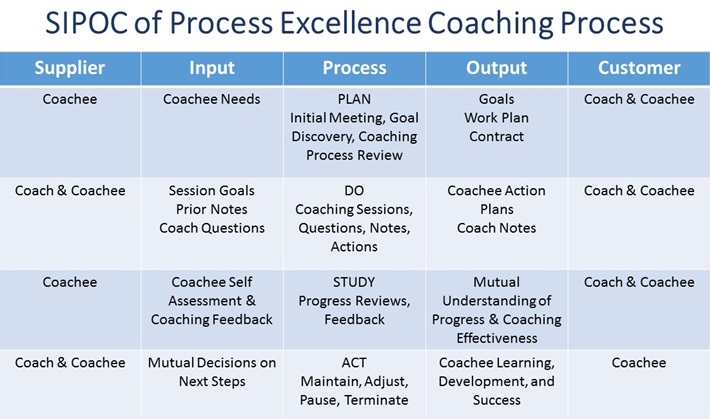Process improvement professionals and teams can learn how to create more value through regular, on-going coaching geared towards their role and performance expectations. In one recent study of trained Green Belts, those with coaching support delivered net benefits that were more than eight times greater than those working a project without coaching. (source: Adam Bowden, 2016)
Process Excellence coaching is different from teaching or cheerleading. Your coaches must employ methods that enable coachee self-discovery and removal of barriers that are holding them back. For this, Process Excellence Coaches need to define their coaching process.
Coach Role and Responsibilities
While coaching opportunities may focus on the successful execution of an improvement initiative or a specific challenge, the coach’s goal is to stimulate self-development on the part of the coachee. Coaches need to know the methods to use and the process to follow to achieve this goal.
Coaches must also know how to create an environment of mutual trust and respect. The number one responsibility of the coach is to protect confidentiality of sensitive discussions that may occur. Coaches also need to help build accountability and responsibility on the part of the coachee. Accordingly, coaches must role model these characteristics in their coaching contacts and relationships.
The primary tactic of the coach is to ask good questions and be a good listener. This will be discussed more in the coaching process below. Finally, the coach should focus on guiding the coaching process, but typically not to prescribe how the coachee achieves his or her goals.
Types of Coaching
Within the coaching process, approaches can vary based upon the specific or immediate need of the person receiving the coaching. Key factors in deciding the best approach include the current competency and goals of the person receiving the coaching, and the needs of the organization. Four types of coaching are addressed in a prior article Applying the Right Coaching Approach for Process Improvement Practitioners. This article applies mostly to developmental coaching. Regardless, it is important for Process Excellence coaches to know and use the correct approach for each specific coaching engagement. Even more importantly, the approaches must be applied in the context of a sound coaching process.
The Coaching Process
While many processes have been written about and practiced, I prefer to apply the classic Plan-Do-Study-Act (PDSA) process to coaching. Could anything be more fitting in the field of process improvement? Here is how it works when applied to process excellence coaching.
PLAN
In the initial meeting between the coach and coachee, the reason for coaching should be discussed. In particular, the coach needs to discover the coachee goals. Initial goals may be high level; more specific goals will emerge as the coaching process continues. The coach should seek to draw out initial concerns, or perceived barriers to achievement of goals. A work plan should also be discussed, including coaching schedules and a review of what coaching sessions will look like, including preparation, the actual session, and follow through.
It is best practice to ratify these discussions by signing a coaching contract. This is not a legal document, but a simple agreement between the coach and the coachee that clarifies goals, roles, and expectations in the coaching process.
DO
The next step of the process is to conduct coaching sessions. The meetings should begin with a review of coaching goals – both overall and for the specific coaching session. It is appropriate for the coach to review and verbally debrief notes from prior coaching sessions. Coaching plans may also be confirmed sometime during the meeting.
The primary activity in the session is for the coach to ask effective questions. A good approach for asking questions is to follow the GROW model popularized by John Whitmore. Coaches can also benefit from the concept of Humble Inquiry, a term introduced by Edgar H. Schein in in his book Helping: How to Offer, Give, and Receive Help (February 14, 2011). Schein provided the following definition: “Humble Inquiry is the fine art of drawing someone out, of asking questions to which you do not already know the answer, of building a relationship based on curiosity and interest in the other person.” In his follow-up articles and books, he discussed many examples of how asking questions instead of stating opinions or instruction can uncover important information for the coach and deeper thought by the coachee.
As example, a person may want to know how to address a challenging situation in a process change initiative. The process excellence coach may be tempted to be the expert and tell the person what he believes is the best approach. However, the coach has deprived the person of the opportunity to explore options and discover for themselves an effective approach to try.
The coach should keep detailed notes of all coaching sessions. Notes should include topics discussed, coach comments, and actions agreed to. This provides a quick reference for each new session, as well as a journal of the overall coaching journey. These are private notes for the coach, but key points should be verbally reviewed during coaching sessions. Coachees should also keep a record of goals and actions agreed to during coaching sessions. It is good practice for the coachee to follow-up the coaching sessions with a quick email to the coach documenting these agreements.
STUDY
As part of coaching process, there should be a periodic review of recent progress, and challenges that are preventing or slowing goal accomplishment. The coachee is encouraged to self-assess progress towards meeting goals short-term and longer-term. The coach should ask for feedback on the coaching process to learn what is working and what is not.
ACT
Based upon progress reviews and feedback, the coach and coachee should review and update the coaching work plan and next steps. In many cases, the decision may be to continue as is. Sometimes a decision will be made to adjust approaches to better meet the needs of the coachee. When this happens, a timeframe should be established to revisit this change to see if the desired effect occurred. Eventually, all coaching relationships come to an end, or are put on pause. Ideally, this occurs when the coaching goals have been achieved and there is no need to continue the coaching at the present. The coaching process may be reactivated later if new reasons surface where coaching can be helpful.
If the coaching relationship is terminated due to a perceived lack of effectiveness, then the coach should attempt to diagnose the causes and learn from the experience. There may be opportunity to refine coaching approaches and further aid goal achievement by future coachees.
Conclusion
Process Excellence Coaching can make the difference between making small incremental improvements versus organizational transformation to broad-based improvements with sustainable results. To be successful, the coaches must follow a defined process, and not simply conduct coaching activities. Process Excellence Coaches who develop their own coaching skills and follow a defined process will be invaluable to the organization and achievement of organizational goals. Know your Process Excellence Coaching process and follow it.
About Er Ralston
 Er Ralston is an accomplished coach, trainer, and advisor, specializing in business process excellence, strategic and tactical business planning, Lean management systems, Six Sigma improvement methodology, and the Malcolm Baldrige National Quality Award criteria for performance excellence. Er brings more than 30 years of experience in numerous operations and quality leadership interventions. He is a Lean expert and certified Six Sigma Master Black Belt.
Er Ralston is an accomplished coach, trainer, and advisor, specializing in business process excellence, strategic and tactical business planning, Lean management systems, Six Sigma improvement methodology, and the Malcolm Baldrige National Quality Award criteria for performance excellence. Er brings more than 30 years of experience in numerous operations and quality leadership interventions. He is a Lean expert and certified Six Sigma Master Black Belt.





